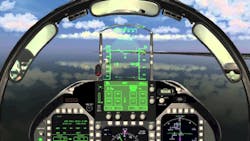Navy considers open-systems-architecture data fusion systems for Super Hornet and Growler combat jets
RIDGECREST, Calif. – U.S. Navy aerial warfare experts are reaching out to industry in attempts to find suitable enabling technologies for designing data fusion systems for the Navy F/A-18E/F Super Hornet jet fighter-bomber, and the EA-18G Growler electronic warfare (EW) combat jet.
Officials of the Naval Air Warfare Center Weapons Division (NAWCWD) at China Lake Naval Air Weapons Station in Ridgecrest, Calif., have issued a request for information (N6893622R0024) for the Data Fusion System for F/A-18E/F and EA-18G platforms project.
Researchers are trying to better understand current state-of-the-art capabilities and strategies to determine the best data-fusion solution for the Super Hornet and Growler combat jets.
Data fusion integrates several data sources to produce information that is more consistent, accurate, and useful than that provided by any individual data source, such as how humans and animals use data information from several senses to improve their ability to survive.
From industry, Navy researchers want to know about each company's qualifications for designing sensor fusion systems; technological alternatives for advanced machine learning and artificial intelligence algorithms; automated and integrated test simulation; single-platform vs. multi-platform resource management; commonality with other Navy data-fusion systems; networking solutions; targeting algorithms; sensor logic; multi-level security; and requirements for hardware and networking.
Researchers also want to know the company's alternatives for modular open-systems architecture design for software and hardware; allocation sensor fusion to subsystems and sensors; crew and vehicle interfaces; how sensor fusion could enhance survivability, lethality, situational awareness, and reduce crew workload.
Navy researchers also want to know where proposed technologies have been used previously; how to conduct incremental data fusion at each sensor and intermediate processor; how the data-fusion system has been tested and evaluated; and previous relevant contracts.
Companies interested should email 20-page responses no later than 23 May 2022 to the Navy's Bobby Kapadia at [email protected]. Responses may have as many as five attachments of briefing slides, pre-printed commercial brochures, or sales literature.
More information is online at https://sam.gov/opp/90403781ec164338b0c6fa753469d0ae/view.
About the Author
John Keller
Editor-in-Chief
John Keller is the Editor-in-Chief, Military & Aerospace Electronics Magazine--provides extensive coverage and analysis of enabling electronics and optoelectronic technologies in military, space and commercial aviation applications. John has been a member of the Military & Aerospace Electronics staff since 1989 and chief editor since 1995.
